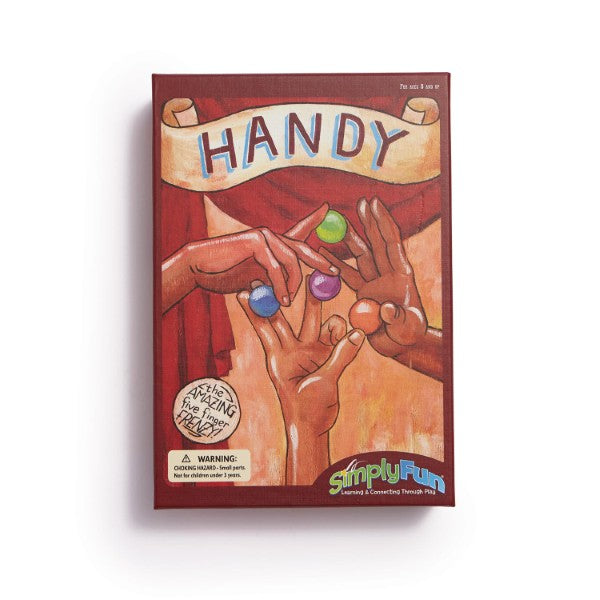
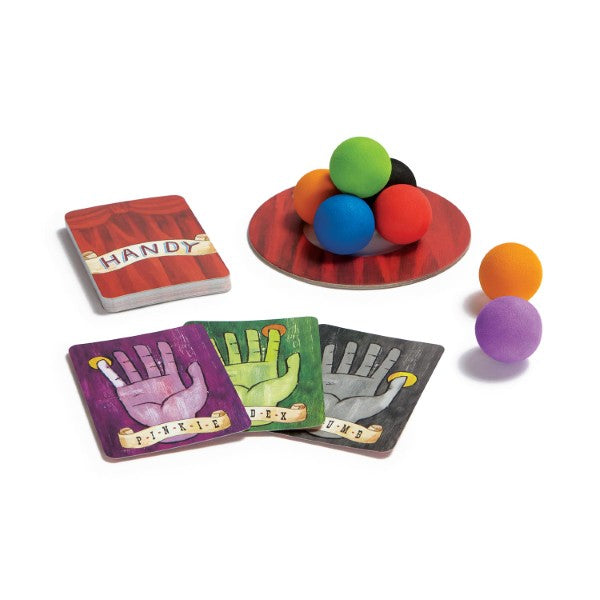
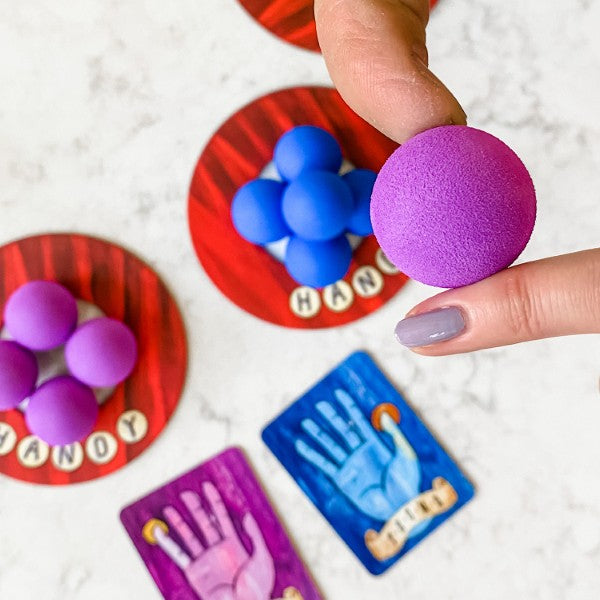
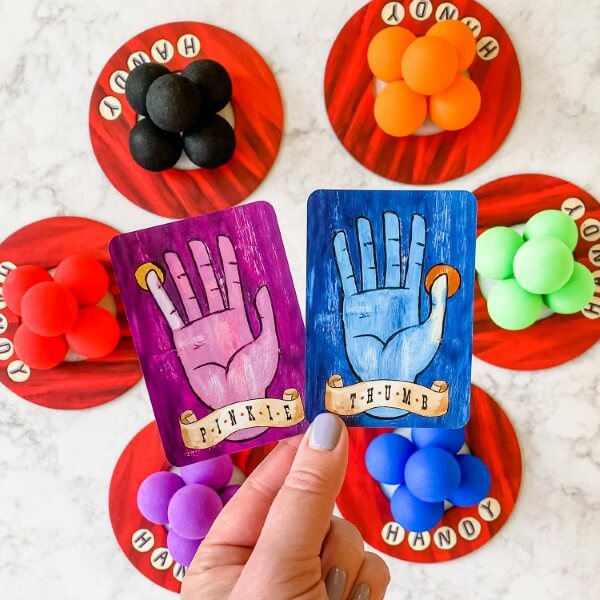
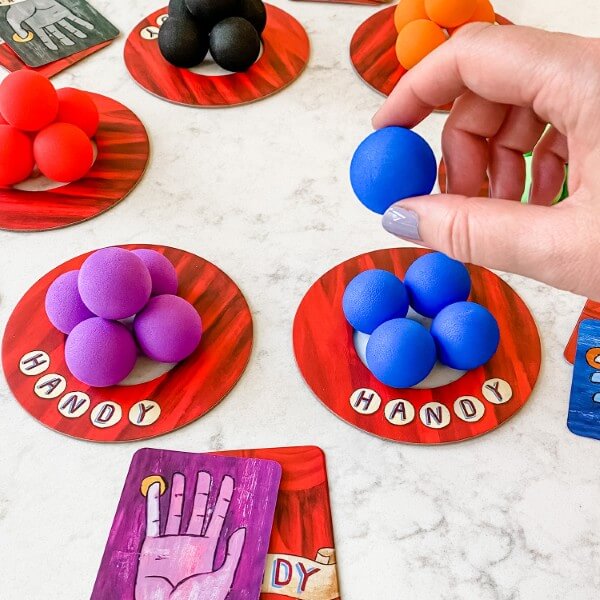
Collapsible content
With partners on either side, balance the spongy balls between your fingers while more and more balls get added to the hand tree. For 2-6 players, ages 8 and up, this game gets better with more people.
The game comes with six sets of colored balls, six ball holder rings, and six sets of finger instruction cards. But the most important part of the game isn’t even in the box… it’s your own hands!
Handy is a totally unique kind of game that’s a whole lot of fun. You’ve definitely never played anything like this before. It’s easy to learn the basics, but very challenging to master and completely unpredictable! Its a great way to get folks laughing and playing together quickly!
Here’s how to play. You are partners with players seated on either side of you, and share a pile of balls with each of them. All players have one hand in the middle of the table in the “hand tree” while their other hand remains free to turn over cards and add new balls.
The player with the smallest hand goes first - he and the teammate on his left each turn over their top card and then they must hold a ball together between the fingers shown.
The second player now turns over another card, and connects the next player into the hand tree.
Continue in this fashion around the table until one team drops a ball. That team loses their ball and places it back into the game box. Now all players return their balls to the holders, shuffle their finger cards and begin a new hand tree starting with the team who dropped the ball.
The round ends when the turn comes around to a team who has no balls remaining in their ring.
Each team should count the number of balls they still have - both in play or in their holder. Scores are noted on paper, and the round is over. All teams receive all 5 balls to start a new round. Play 3 rounds to see which team has the most points and is declared the winner!
Remember that the key to Handy is keeping a steady hand. It sounds simple... just don’t drop the ball! One way to up the fun is to add some challenges after the first round. Maybe the team in first place has to do something silly like hum a tune through the round. Use your imagination and remember….the more they laugh, the harder it is to keep still!


Core Standard*: None


Explore
What Does Child Do To Use Skill In The Game?
Players explore how to position and hold balls with their hands.
How Parents Can Assist Learning
Parents can encourage younger children to look closely and talk through their options with their partner prior to choosing how to position their hand and ball.
Learning Implications and Educator Support
Educators can encourage younger children to look closely and talk through their options with their partner prior to choosing how to position their hand and ball.
Determine
What Does Child Do To Use Skill In The Game?
Players determine optimal position for holding balls.
How Parents Can Assist Learning
Educators can encourage younger children to look closely and talk through their options with their partner prior to choosing how to position their hand and ball. Additionally, use positional words like front or back, and pressure words like lighter or stronger. This will help develop relevant vocabulary through experiential learning.
Learning Implications and Educator Support
Educators can encourage younger children to look closely and talk through their options with their partner prior to choosing how to position their hand and ball. Additionally, use positional words like front or back, and pressure words like lighter or stronger. This will help develop relevant vocabulary through experiential learning.
Compare
What Does Child Do To Use Skill In The Game?
Players need to compare at least one attribute from a dealt card with their face up card.
How Parents Can Assist Learning
No specific adult support required.
Learning Implications and Educator Support
No specific adult support required.
Remember
What Does Child Do To Use Skill In The Game?
Based on previous turns or games, players may remember how best to position and hold a ball.
How Parents Can Assist Learning
Ask children to recall what just happened in the prior move. Also, ask them to identify if the current hand positions reminds them of any situations in the past. If so, what do they remember, and can it help them make a better choice for their turn?
Learning Implications and Educator Support
Ask children to recall what just happened in the prior move. Also, ask them to identify if the current hand positions reminds them of any situations in the past. If so, what do they remember, and can it help them make a better choice for their turn?
Plan
What Does Child Do To Use Skill In The Game?
Players need to talk with their partner, and to look at the existing hand tree, in order to decide what to do on their turn.
How Parents Can Assist Learning
Educators can encourage younger children to look closely and talk through their options with their partner prior to choosing how to position their hand and ball. Additionally, use positional words like front or back, and pressure words like lighter or stronger. This will help develop relevant vocabulary through experiential learning.
Learning Implications and Educator Support
Educators can encourage younger children to look closely and talk through their options with their partner prior to choosing how to position their hand and ball. Additionally, use positional words like front or back, and pressure words like lighter or stronger. This will help develop relevant vocabulary through experiential learning.
Practice
What Does Child Do To Use Skill In The Game?
Children practice fine motor dexterity and finger isolation.
How Parents Can Assist Learning
No specific parents support required. However, as children play, they are also learning about empathy, cooperation and collaboration as they work together with their partner to get their hands and balls into the right orientation.
Learning Implications and Educator Support
No specific educator support required. However, as children play, they are also learning about empathy, cooperation and collaboration as they work together with their partner to get their hands and balls into the right orientation.
*Data compiled from CCSSI ELA Standards, WA Science Standards, and Washington Social Studies Standards


Cognitive
Suggestions for How to Modify Play Experience
Do spoon races with the balls. Each child (or team) has five balls of one color. They must race across the room with a ball in a spoon and deposit the ball in a box top. The player then comes back for another ball or hands the spoon to the next teammate to run the next ball. The first player (or team) to get all five balls in the box wins. At the end of each turn, children must say how many balls are in the box and how many are remaining. This adds and element of simple math.
Communication
Suggestions for How to Modify Play Experience
Create slalom races for 2 players.
Option 1) Set up three rings in a row side-by-side on the table. Give each player a straw. At "Go" each player must blow their ball around each ring to the end of the course.
Option 2)Set up all rings down a long table or on the floor. Players start at opposite ends of the table and blow their ball toward the other end. First to the other end wins, but watch out for your opponent! Time each player on the slalom course.
These games are good for developing breath control, which can be helpful for children who need greater control for longer sentence production.
Sensorimotor
Suggestions for How to Modify Play Experience
Set up five rings on the floor. Write a point value on a piece of paper and put it under each ring. Give each player 3 balls of their color. Let the first player draw a card of their color and then push the ball to a ring of their choice on the floor using the designated finger only. The child with the highest point score after 5 turns wins. This modification encourages finger differentiation and fine motor control.
Make up a putt-putt game. Set up the rings two high (so the ball will stay in) on a three-hole putt-putt course in the house. Each child take one ball of a different color and a tool from around the house to use as a "golf club", such as a cardboard tube or wooded spoon. Children take turns trying to get their ball into each subsequent hole, with each child getting one try per turn. Children must follow their ball and start their next turn from where the ball lands. This can be fun, as the household will have its own hazards (ex: ball goes under the chair). Children can also make tunnels or other "traps" on the course. This variation builds eye-hand coordination, and gross motor coordination.
Do spoon races with the balls. Each child (or team) has five balls of one color. The must race across the room with a ball in a spoon and deposit the ball in a box top. The player then comes back for another ball or hands the spoon to the next team mate to run the next ball. The first player (or team) to get all five balls in the box wins. Playing with a team builds cooperation and encourages children to cheer each other on.
Social Emotional/Behavioral
Suggestions for How to Modify Play Experience
Make up a putt-putt game. Set up the rings two high (so the ball will stay in) on a three-hole putt-putt course in the house. Each child take one ball of a different color and a tool from around the house to use as a "golf club", such as a cardboard tube or wooded spoon. Children take turns trying to get their ball into each subsequent hole, with each child getting one try per turn. Children must follow their ball and start their next turn from where the ball lands. This can be fun, as the household will have its own hazards (ex: ball goes under the chair). Children can also make tunnels or other "traps" on the course. Children will take turns, but also laugh at where their ball ends up, making this a good game for social exchange.
Do spoon races with the balls. Each child (or team) has five balls of one color. The must race across the room with a ball in a spoon and deposit the ball in a box top. The player then comes back for another ball or hands the spoon to the next team mate to run the next ball. The first player (or team) to get all five balls in the box wins. Playing with a team builds cooperation and encourages children to cheer each other on.
Vision
Suggestions for How to Modify Play Experience
This game is not recommended for children with vision concerns.
Hearing
Suggestions for How to Modify Play Experience
Children with hearing impairment can play with signed and gestured directions.
*Data compiled from CCSSI ELA Standards, WA Science Standards, and Washington Social Studies Standards


Autism Special Considerations
Appears to ignore other's communication and/or has difficulty giving eye contact to a communication partner
Is This Game Appropriate for Child with Characteristic? Yes
Can Child with Characteristic Play Game w/o Modification? Yes
Strategies for Developing Compensatory Skills:
Sit or stand at an angle to the child, so direct eye contact is not needed.
Look at the balls instead of each other.
Has difficulty understanding complex verbal directions
Is This Game Appropriate for Child with Characteristic? Yes
Can Child with Characteristic Play Game w/o Modification? Yes
Strategies for Developing Compensatory Skills:
Combine short verbal instructions with visual and physical examples of each step.
Use photos to illustrate what needs to be done. These can be taken ahead of time. The combination of pictures and actions reinforces learning the steps. Also, take pictures during the game for use in later discussions about the game and what happened. (These would need to be taken by someone not playing the game.)
Check for comprehension by asking the child to show you what to do next.
Let children read the directions as they are explained. Visualizing the words is often a stronger learning method for children with autism.
Uses vocabulary inaccurately or demonstrates echolalia (repeating another's speech)
Is This Game Appropriate for Child with Characteristic? No
Can Child with Characteristic Play Game w/o Modification?
Strategies for Developing Compensatory Skills:
This game requires communication among players. Children who demonstrate echolalia might not be able to carry on the needed conversation.
Gets stuck repeating a verbal topic or physical actions and/or has difficulty attending to others' actions or topic.
Is This Game Appropriate for Child with Characteristic? No
Can Child with Characteristic Play Game w/o Modification?
Strategies for Developing Compensatory Skills:
This game requires communication among players. Children who demonstrate echolalia might not be able to carry on the needed conversation.
Has difficulty producing speech/communication
Is This Game Appropriate for Child with Characteristic? No
Can Child with Characteristic Play Game w/o Modification?
Strategies for Developing Compensatory Skills:
This game requires communication among players. Children who demonstrate echolalia might not be able to carry on the needed conversation.
Has difficulty sequencing multi-step actions and/or doing complex abstract tasks
Is This Game Appropriate for Child with Characteristic? No
Can Child with Characteristic Play Game w/o Modification?
Strategies for Developing Compensatory Skills:
Complex fine motor skills are needed combined with multistep actions. The game is not appropriate for children with this concern.
Demonstrates difficulty initiating and maintaining social interactions
Is This Game Appropriate for Child with Characteristic? No
Can Child with Characteristic Play Game w/o Modification?
Strategies for Developing Compensatory Skills:
Handy requires constant social interaction and therefore the game is not appropriate for children with this concern.
Acts out or demonstrates avoidance behaviors when frustrated, overwhelmed, or needs more sensory input.
Is This Game Appropriate for Child with Characteristic? No
Can Child with Characteristic Play Game w/o Modification?
Strategies for Developing Compensatory Skills:
Handy is not recommended for children who have difficulty regulating emotions or behaviors. The game requires focus and control.
Needs sameness or consistent routines and/or has difficulty with transitions from one activity to another
Is This Game Appropriate for Child with Characteristic? Yes
Can Child with Characteristic Play Game w/o Modification? No
Strategies for Developing Compensatory Skills:
Play games at the same time every day, so the child anticipates the game routine.
Change the location of the game, so the child may play in different rooms, at the table, or on the floor. This will build tolerance for variation.
Prepare the child ahead time for the introduction of a new game. Talk about aspects that will be motivating for the child, and let them explore the parts of the game before setting out the whole game.
Provide a structure for placement of game pieces that can be the same each time the game is played. For example, have a specific location for where the board goes, the pieces, etc.
Involve the child verbally and with actions for the transition to the game table or at the end of game play. For example, you might say, "Let's look at the pictures on the game box and guess what it is about." Use an object cue. If you were intending to play Handy you would hand the child a ball from the game and say, "Look here is a ball. Let's see what we do with it."
Has difficulty understanding others' feelings, intentions, and the reasons for others' actions.
Is This Game Appropriate for Child with Characteristic? No
Can Child with Characteristic Play Game w/o Modification?
Strategies for Developing Compensatory Skills:
Children need to pay attention to other players on both sides of their bodies. Not recommended for children who cannot attend to others' words and actions.
*Data compiled from CCSSI ELA Standards, WA Science Standards, and Washington Social Studies Standards


Extra Ways to Play the Game
Rule change: Allow the balls to touch each other to simplify the game.
Materials Needed
No additional materials needed.
Developmental Benefits
This may reduce frustration and enable children to be more successful.
Extra Ways to Play the Game
Make up a "Skee-Ball" type of game. Set up the rings on the table or floor in any order or stacked height. Give each ring a point value of the children's choice, which might include distance and height of rings. Players then get 5 balls of one color to roll or bounce into a ring. Add up points for each ball that lands in a ring.
Materials Needed
Write point values on pieces of paper to put under each ring.
Developmental Benefits
This variation builds eye-hand coordination and has children use addition skills. Children also use planning to determine how to arrange the set up for the game.
Extra Ways to Play the Game
Create slalom races for 2 players. Option 1) Set up three rings in a row side-by-side on the table. Give each player a straw. At "Go" each player must blow their ball around each ring to the end of the course. Option 2) Set up all rings down a long table or on the floor. Players start at opposite ends of the table and blow their ball toward the other end. First to the other end wins, but watch out for your opponent! Time each player on the slalom course.
Materials Needed
Straws. Timer for timed game.
Developmental Benefits
Each option involves experimentation, planning, and strategy. Motor planning is also involved as players need to determine where to position their bodies to achieve the best result.
Extra Ways to Play the Game
Make up a putt-putt game. Set up the rings two high (so the ball will stay in) on a three-hole putt-putt course in the house. Each child take one ball of a different color and a tool from around the house to use as a "golf club", such as a cardboard tube or wooded spoon. Children take turns trying to get their ball into each subsequent hole, with each child getting one try per turn. Children must follow their ball and start their next turn from where the ball lands. This can be fun, as the household will have its own hazards (ex: ball goes under the chair). Children can also make tunnels or other "traps" on the course. This variation builds eye-hand coordination, and gross motor coordination.
Materials Needed
Tools such as cardboard tubes, wooded spoons, etc.
Developmental Benefits
This game involves gross motor and fine motor movements. Children also experiment with force of movement, trajectory, and directionality. Creativity is also involved in making the course and the obstacles on the course.
*Data compiled from CCSSI ELA Standards, WA Science Standards, and Washington Social Studies Standards






